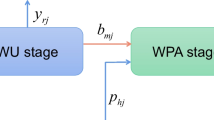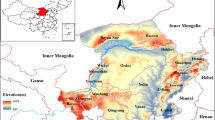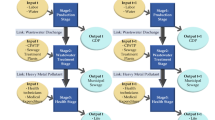Abstract
With per capita water resources at only around a quarter of the world average, China’s water resources are limited and unevenly distributed. Past research on water resource utilization has mainly focused on industrial water use (agriculture and industry), water plant ownership efficiencies (private or public operation), or water resources and economic production; however, there have been few studies focused on water supply livelihood. Therefore, this paper considered both industrial production water services, non-production water services (public sector and residential water use), and water leakage losses, which is a water supply problem seldom mentioned in other studies. An undesirable directional distance function (DDF) dynamic data envelopment analysis (DEA) model was employed for the dynamic analysis as it was able to deal with both desirable and undesirable outputs at the same time. The model examined collected water supply and water leak efficiency data from 30 Chinese provinces/municipalities from 2007 to 2018, from which it was found that (1) Beijing, Gansu, Guangdong, and Ningxia had efficient water supply and water leak losses from 2007 to 2018 and the most improved province was Jiangxi; (2) the eastern provinces, in general, had better water efficiencies and the central and western provinces needed greater improvements; and (3) the lowest water leakage loss efficiencies were in Inner Mongolia, Jiangxi, and Heilongjiang, all of which required significant improvements.


Similar content being viewed by others
Data availability
Not applicable
References
Abbott M, Cohen B, Wang WC (2012) The performance of the urban water and wastewater sectors in Australia. Util Policy 20(1):52–63
Allan G (2006) Assessing capital efficiency in the water and sewerage industry in England and Wales: Ofwat’s approach. Util Policy 14(4):224–233
Ananda J (2018) Productivity implications of the water-energy-emissions nexus: an empirical analysis of the drinking water and wastewater sector. J Clean Prod 196:1097–1105
Ananda J (2019) Explaining the environmental efficiency of drinking water and wastewater utilities. Sustainable Production and Consumption 17:188–195
Banda EM, Mwale FD (2018) Utility performance in supplying water to informal settlements: a case study from Malawi. Util Policy 55:151–157
Banker RD, Charnes A, Cooper WW (1984) Some models for estimating technical and scale inefficiencies in data envelopment analysis. Manag Sci 30(9):1078–1092
Barbosa A, Cesário de Lima S, Brusca I (2016) Governance and efficiency in the Brazilian water utilities: a dynamic analysis in the process of universal access. Util Policy 43:82–96
Barros CFA, Souza MBG, Barbosa FAR (2006) Seasonal mechanisms driving phytoplankton size structure in a tropical deep lake (Dom Helvécio Lake, South-East Brazil). Acta Limnol Bras 18:55–66
Barros CP, Managi S, Matousek R (2012) The technical efficiency of the Japanese banks: non-radial directional performance measurement with undesirable output. Omega 40(1):1–8
Bian Y, Yan S, Xu H (2014) Efficiency evaluation for regional urban water use and wastewater decontamination systems in China: a DEA approach. Resour Conserv Recycl 83:15–23
Bogetoft P, Färe R, Grosskopf S, Hayes K and Taylor L (2008) Network DEA: some applications and illustrations. Proceedings of DEA symposium
Buafua PM (2015) Efficiency of urban water supply in Sub-Saharan Africa: do organization and regulation matter? Util Policy 37:13–22
Byrnes J, Crase L, Dollery B, Villano R (2010) The relative economic efficiency of urban water utilities in regional New South Wales and Victoria. Resour Energy Econ 32(3):439–455
Carvalho P, Marques RC (2011) The influence of the operational environment on the efficiency of water utilities. J Environ Manag 92(10):2698–2707
Chang H, Choy HL, Cooper WW, Ruefli TW (2009) Using Malmquist indexes to measure changes in the productivity and efficiency of US accounting firms before and after the Sarbanes–Oxley Act. Omega 37(5):951–960
Charnes A, Cooper WW, Rhodes E (1978) Measuring the efficiency of decision making units. Eur J Oper Res 2(6):429–444
Chen CM (2009) Network-DEA, a model with new efficiency measures to incorporate the dynamic effect in production networks. Eur J Oper Res 194(3):687–699
Chiu Y-h, Huang C-w, Ting C-t (2012) A non-radial measure of different systems for Taiwanese tourist hotels’ efficiency assessment. CEJOR 20(1):45–63
Chung YH, Färe R, Grosskopf S (1997) Productivity and undesirable outputs: a directional distance function approach. J Environ Manag 51:229–240
D’Inverno G, Carosic L, Romano G, Guerrini A (2018) Water pollution in wastewater treatment plants: an efficiency analysis with undesirable output. Eur J Oper Res 269(1):24–34
Färe R, Grosskopf S (1996) Productivity and intermediate products: a frontier approach. Econ Lett 50(1):65–70
Färe R, Grosskopf S (2010) Directional distance functions and slacks-based measures of efficiency. Eur J Oper Res 200:320–322
Färe R, Grosskopf S, Norris M, Zhang Z (1994) Productivity growth, technical progress, and efficiency change in industrialized countries. Am Econ Rev 84(1):66–83
Farrell MJ (1957) The measurement of productive efficiency. Journal of the Royal Statistical Society. Series A (General) 120(3):253–290
Ferro G, Mercadier AC (2016) Technical efficiency in Chile’s water and sanitation providers. Util Policy 43:97–106
Ferroa G, Lentini EJ, Mercadier AC, Romero CA (2014) Efficiency in Brazil’s water and sanitation sector and its relationship with regional provision, property and the independence of operators. Util Policy 28:42–51
Gadanakis Y, Bennett R, Park J, Areal FJ (2015) Improving productivity and water use efficiency: a case study of farms in England. Agric Water Manag 160:22–32
Guerrini A, Romano G, Mancusoc F, Carosi L (2016) Identifying the performance drivers of wastewater treatment plants through conditional order-m efficiency analysis. Util Policy 42:20–31
Guerrini A, Molinos-Senante M, Romano G (2018) Italian regulatory reform and water utility performance: an impact analysis. Util Policy 52:95–102
Higuerey A, Trujillo L, González MM (2017) Has efficiency improved after the decentralization in the water industry in Venezuela? Util Policy 49:127–136
Hu J-L, Wang S-C, Yeh F-Y (2006) Total-factor water efficiency of regions in China. Res Policy 31(4):217–230
Kao C (2008) Network data envelopment analysis: current development and future research. Asia-Pacific productivity conference
Landriani L, Lepore L, D’Amore G, Pozzoli S, Alvino F (2019) Decorporatization of a municipal water utility: a case study from Italy. Util Policy 57:43–47
Luenberger DG (1992) Benefit functions and duality. J Math Econ 21(5):461–481
Mbuvi D, De Witte K, Perelman S (2012) Urban water sector performance in Africa: a step-wise bias-corrected efficiency and effectiveness analysis. Util Policy 22:31–40
Mellah T, Amor TB (2016) Performance of the Tunisian water utility: an input-distance function approach. Util Policy 38:18–32
Mugisha S (2007) Effects of incentive applications on technical efficiencies: empirical evidence from Ugandan water utilities. Util Policy 15(4):225–233
Nemoto J, Goto M (1999) Dynamic data envelopment analysis: modeling intertemporal behavior of a firm in the presence of productive inefficiencies. Econ Lett 64(1):51–56
Nemoto J, Goto M (2003) Measurement of dynamic efficiency in production: an application of data envelopment analysis. J Prod Anal 19(2–3):191–210
Nourali AE, Davoodabadi M, Pashazadeh H (2014) Regulation and efficiency & productivity considerations in water & wastewater industry: case of Iran. Procedia Soc Behav Sci 109(8):281–289
Picazo-Tadeo AJ, Sáez-Fernández FJ, González-Gómez F (2008) Does service quality matter in measuring the performance of water utilities? Util Policy 16(1):30–38
Roekmi RAK, Chua LHC, Baskaran K (2018) Analysing piped water service provider performance based on consumer perceptions. Util Policy 55:79–89
Romano G, Guerrini A (2011) Measuring and comparing the efficiency of water utility companies: a data envelopment analysis approach. Util Policy 19(3):202–209
Romano G, Guerrini A (2014) The effects of ownership, board size and board composition on the performance of Italian water utilities. Util Policy 31:18–28
Romano G, Molinos-Senante M, Guerrini A (2017) Water utility efficiency assessment in Italy by accounting for service quality: an empirical investigation. Util Policy 45:97–108
See KF (2015) Exploring and analysing sources of technical efficiency in water supply services: some evidence from Southeast Asian public water utilities. Water Resources and Economics 9:23–44
See KF, Ma Z (2018) Does non-revenue water affect Malaysia’s water services industry productivity? Util Policy 54:125–131
Shephard RW (1970) The theory of cost and production functions. Princeton University Press, Princeton
Silvestre HC (2012) Public–private partnership and corporate public sector organizations: alternative ways to increase social performance in the Portuguese water sector? Util Policy 22:41–49
Tone K (2001) A slacks-based measure of efficiency in data envelopment analysis. Eur J Oper Res 130(3):498–509
Tone K, Tsutsui M (2010) Dynamic DEA: a Slacks-based measure approach. Omega 38:145–156
Yan J (2019) Spatiotemporal analysis for investment efficiency of China’s rural water conservancy based on DEA model and Malmquist productivity index model. Sustainable Computing: Informatics and Systems 21:56–71
Yao X, Feng W, Zhang X, Wang W, Zhang C, You S (2018) Measurement and decomposition of industrial green total factor water efficiency in China. J Clean Prod 198:1144–1156
Zhang N, Zhou P, Choi Y (2013) Energy efficiency, CO2 emission performance and technology gaps in fossil fuel electricity generation in Korea: a meta-frontier non-radial directional distance function analysis. Energy Policy 56:653–662
Zhou P, Ang BW, Wang H (2012) Energy and CO2 emission performance in electricity generation: a non-radial directional distance function approach. Eur J Oper Res 221(3):625–635
Zhou X, Luo R, Yao L, Cao S, Wang S, Lev B (2018) Assessing integrated water use and wastewater treatment systems in China: a mixed network structure two-stage SBM DEA model. J Clean Prod 185(1):533–546
Zhou Z, Wu H, Song P (2019) Measuring the resource and environmental efficiency of industrial water consumption in China: a non-radial directional distance function. J Clean Prod 240(10):118169
Funding
This work was supported by the National Natural Science Fund in China, No. 71773082; Sichuan Science project, No. 2020JDR0079; and the Fundamental Research Funds for the Central Universities (Grant No. SCU-BS-PY201016).
Author information
Authors and Affiliations
Corresponding author
Ethics declarations
Ethics approval and consent to participate
Not applicable
Consent for publication
Not applicable
Conflict of interest
The authors declare no competing interests.
Additional information
Responsible Editor: Philippe Garrigues
Publisher’s note
Springer Nature remains neutral with regard to jurisdictional claims in published maps and institutional affiliations.
Highlights
1. An undesirable DDF dynamic DEA model is proposed to explore water supply efficiency changes in China.
2. The eastern Chinese provinces tended to have better overall water supply efficiencies that the central and western provinces.
3. The best water supply efficiencies were in Beijing, Chongqing, Gansu, Guangdong, Ningxia, Shanghai, and Shaanxi.
Rights and permissions
About this article
Cite this article
Li, Y., Chiu, Yh., Li, Y. et al. Dynamic analysis of residential and enterprise water supply and leakage efficiencies. Environ Sci Pollut Res 28, 39471–39492 (2021). https://doi.org/10.1007/s11356-021-13276-z
Received:
Accepted:
Published:
Issue Date:
DOI: https://doi.org/10.1007/s11356-021-13276-z




